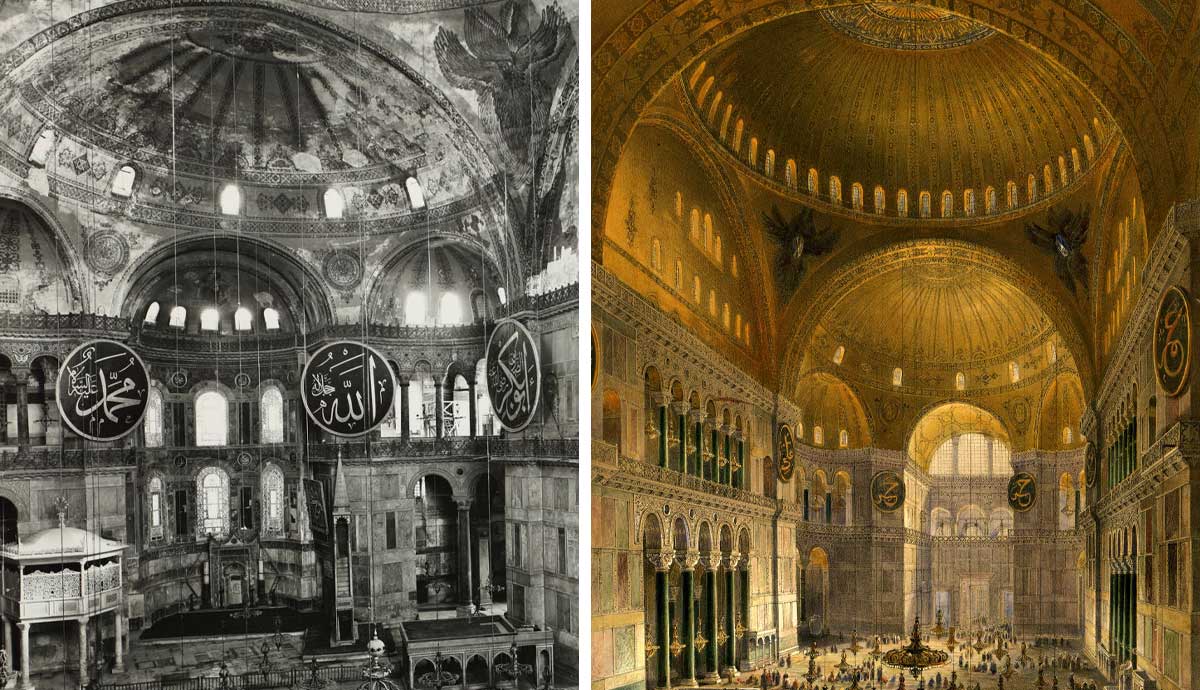Hagia Sophia: A 1600-Year History Of Survival

Table of Contents
From Byzantine Cathedral to Ottoman Mosque: A Transformation Through Time
The Hagia Sophia's history is deeply intertwined with the Byzantine and Ottoman Empires. Its story is one of impressive construction, significant alterations, and adaptation to changing political and religious landscapes. Understanding its evolution requires exploring key moments in its past:
-
Construction under Emperor Justinian I (532-537 AD): Emperor Justinian I commissioned the construction of the Hagia Sophia, aiming to create a structure that would surpass all others and showcase the power and grandeur of the Byzantine Empire. The architectural innovation was astounding for its time, employing massive scale and groundbreaking techniques. The use of pendentives to support the massive dome was a feat of Byzantine engineering that redefined architectural possibilities. Its size and splendor cemented it as the central church of the Eastern Orthodox Church.
-
The impact of the 553 earthquake and subsequent repairs: A devastating earthquake in 553 AD caused significant damage to the original structure. Extensive repairs and renovations were undertaken, demonstrating the importance the Byzantines placed on the preservation of this iconic building. This early repair work highlights its resilience from its very inception.
-
The Ottoman conquest of Constantinople (1453 AD) and the conversion of Hagia Sophia into a mosque: The Ottoman conquest of Constantinople marked a pivotal moment in the Hagia Sophia's history. Sultan Mehmed II, upon conquering the city, converted the cathedral into a mosque, reflecting the change in religious dominance. This conversion involved significant modifications, including the addition of four minarets (later increased to six), a mihrab (prayer niche), and a mimbar (pulpit). These additions, while altering its original function, are integral parts of its fascinating architectural journey and history.
-
Highlighting key architectural features from both the Byzantine and Ottoman periods: The Hagia Sophia showcases a unique blend of Byzantine and Ottoman architectural styles. The massive dome, intricate mosaics, and the overall grandeur of the interior space are hallmarks of Byzantine architecture. The minarets, mihrab, and mimbar, on the other hand, are examples of Ottoman architectural additions. This fusion is a testament to the building's ability to adapt and incorporate different styles throughout its long history.
Hagia Sophia's Architectural Marvels and Engineering Prowess
The Hagia Sophia is not merely a historical landmark; it's a testament to the remarkable engineering and architectural prowess of its creators. Several aspects contribute to its lasting architectural impact:
-
Explain the innovative use of pendentives to support the massive dome: The ingenious use of pendentives, triangular architectural supports, allowed the architects to transition from a square base to a circular dome, a feat of engineering that was revolutionary for its time. This architectural solution enabled the creation of a vast, awe-inspiring interior space.
-
Describe the grandeur of the interior space, focusing on the impressive scale and the use of light: The vast interior space of the Hagia Sophia is breathtaking. The scale of the structure, the height of the dome, and the way natural light filters through the windows create an unparalleled sense of awe and reverence. The interplay of light and shadow dramatically enhances the visual impact of the mosaics and frescoes.
-
Detail the stunning mosaics and frescoes, discussing their artistic significance and the stories they tell: The mosaics and frescoes inside the Hagia Sophia are masterpieces of Byzantine art. They depict religious figures, scenes from the Bible, and historical events, offering a glimpse into the religious beliefs and artistic styles of the time. Many of these have survived centuries of alteration and change.
-
Discuss the structural challenges and repairs undertaken throughout its history, showcasing its resilience: Throughout its history, the Hagia Sophia has faced numerous structural challenges, including earthquakes and the passage of time. The resilience of the structure and the continuous efforts to repair and maintain it are a testament to its enduring strength. It’s a story of survival, adaptation, and preservation.
Hagia Sophia: A Symbol of Cultural Exchange and Preservation
The Hagia Sophia's journey exemplifies the concept of cultural exchange and preservation. Its multifaceted history demonstrates its lasting significance:
-
The secularization of Hagia Sophia in 1935 and its transformation into a museum: In 1935, the Hagia Sophia was secularized and transformed into a museum, reflecting a shift towards a more secular Turkey and its commitment to protecting its historical legacy. This landmark decision ensured its continued preservation and made it accessible to all, regardless of religious affiliation.
-
The ongoing preservation efforts and challenges in maintaining the building: Maintaining a structure as old and complex as the Hagia Sophia presents significant challenges. Ongoing preservation efforts are crucial for ensuring that this architectural masterpiece continues to endure for generations to come.
-
The Hagia Sophia's importance as a UNESCO World Heritage site and its role in fostering intercultural dialogue: The Hagia Sophia's designation as a UNESCO World Heritage site underscores its universal significance. It serves as a powerful symbol of intercultural dialogue, showcasing the convergence of different cultures and religions throughout history.
-
The impact of tourism on the Hagia Sophia and the city of Istanbul: The Hagia Sophia is a major tourist attraction, drawing millions of visitors annually. Tourism generates significant economic benefits for Istanbul, but also presents challenges in terms of managing visitor flow and ensuring the preservation of the building and its surrounding environment.
Conclusion:
The Hagia Sophia’s 1600-year journey reflects not only its incredible architectural achievement but also its enduring significance as a symbol of cultural exchange and resilience. From its origins as a magnificent Byzantine cathedral to its transformation into an Ottoman mosque, and finally, its current status as a museum, the Hagia Sophia has continually adapted and survived. Its story is a testament to the enduring power of human ingenuity and the importance of preserving our shared historical heritage.
Call to Action: Discover more about the captivating history and architectural marvels of the Hagia Sophia. Plan your visit to witness this timeless masterpiece and explore the rich cultural tapestry of Istanbul. Learn more about its Hagia Sophia history, its architectural design, and the countless stories etched within its walls. Immerse yourself in the legacy of the Hagia Sophia, a true symbol of survival and cultural exchange.

Featured Posts
-
 At And T Sounds Alarm On Broadcoms Extreme V Mware Price Increase
Apr 29, 2025
At And T Sounds Alarm On Broadcoms Extreme V Mware Price Increase
Apr 29, 2025 -
 Midland Athlete Vanishes In Las Vegas Urgent Search Underway
Apr 29, 2025
Midland Athlete Vanishes In Las Vegas Urgent Search Underway
Apr 29, 2025 -
 Solve The Nyt Spelling Bee February 10 2025 Puzzle
Apr 29, 2025
Solve The Nyt Spelling Bee February 10 2025 Puzzle
Apr 29, 2025 -
 2025 Nfl Season Justin Herbert And The Chargers Head To Brazil
Apr 29, 2025
2025 Nfl Season Justin Herbert And The Chargers Head To Brazil
Apr 29, 2025 -
 Minnesota Governor Defies Us Attorney General On Transgender Athlete Ban
Apr 29, 2025
Minnesota Governor Defies Us Attorney General On Transgender Athlete Ban
Apr 29, 2025
Latest Posts
-
 20 000 Strong The Trans Rights Protest That Made Headlines
Apr 29, 2025
20 000 Strong The Trans Rights Protest That Made Headlines
Apr 29, 2025 -
 Capital Summertime Ball 2025 London Wembley Stadium Tickets And Event Details
Apr 29, 2025
Capital Summertime Ball 2025 London Wembley Stadium Tickets And Event Details
Apr 29, 2025 -
 Capital Summertime Ball 2025 Your Guide To Wembley Stadium Show
Apr 29, 2025
Capital Summertime Ball 2025 Your Guide To Wembley Stadium Show
Apr 29, 2025 -
 Wembley Stadiums Capital Summertime Ball 2025 Dates Tickets And More
Apr 29, 2025
Wembley Stadiums Capital Summertime Ball 2025 Dates Tickets And More
Apr 29, 2025 -
 Canoe Awakening A Cultural Celebration
Apr 29, 2025
Canoe Awakening A Cultural Celebration
Apr 29, 2025
